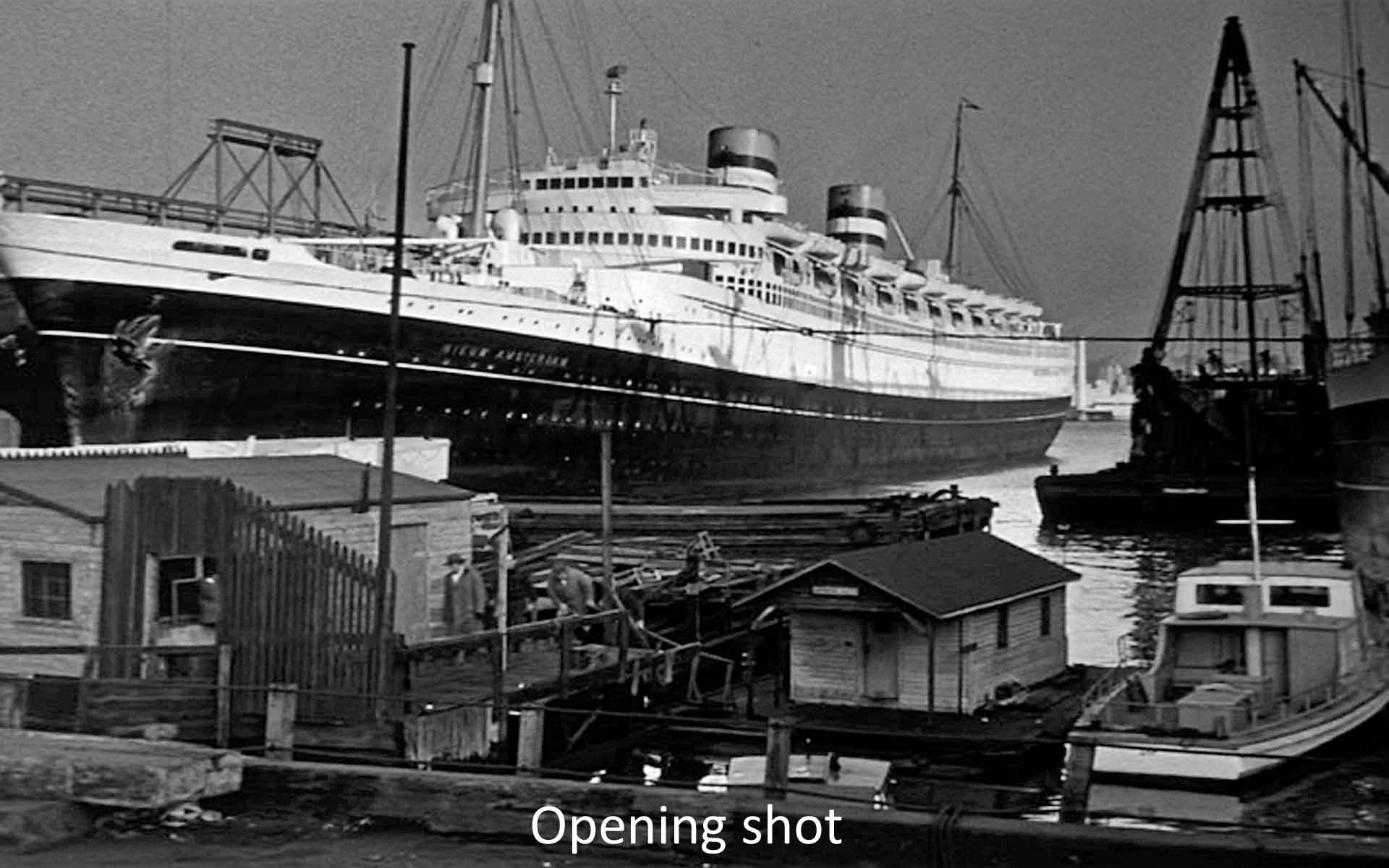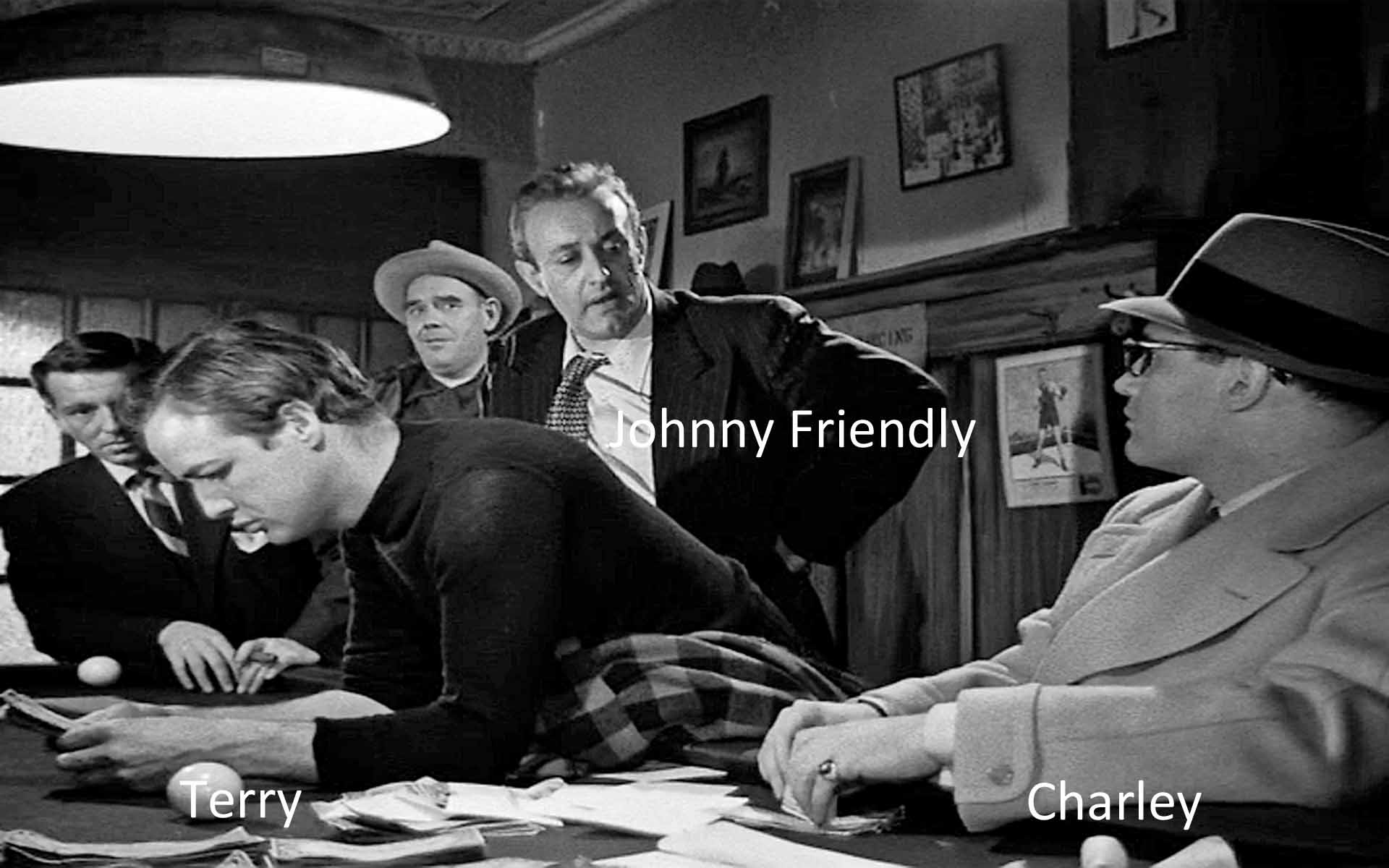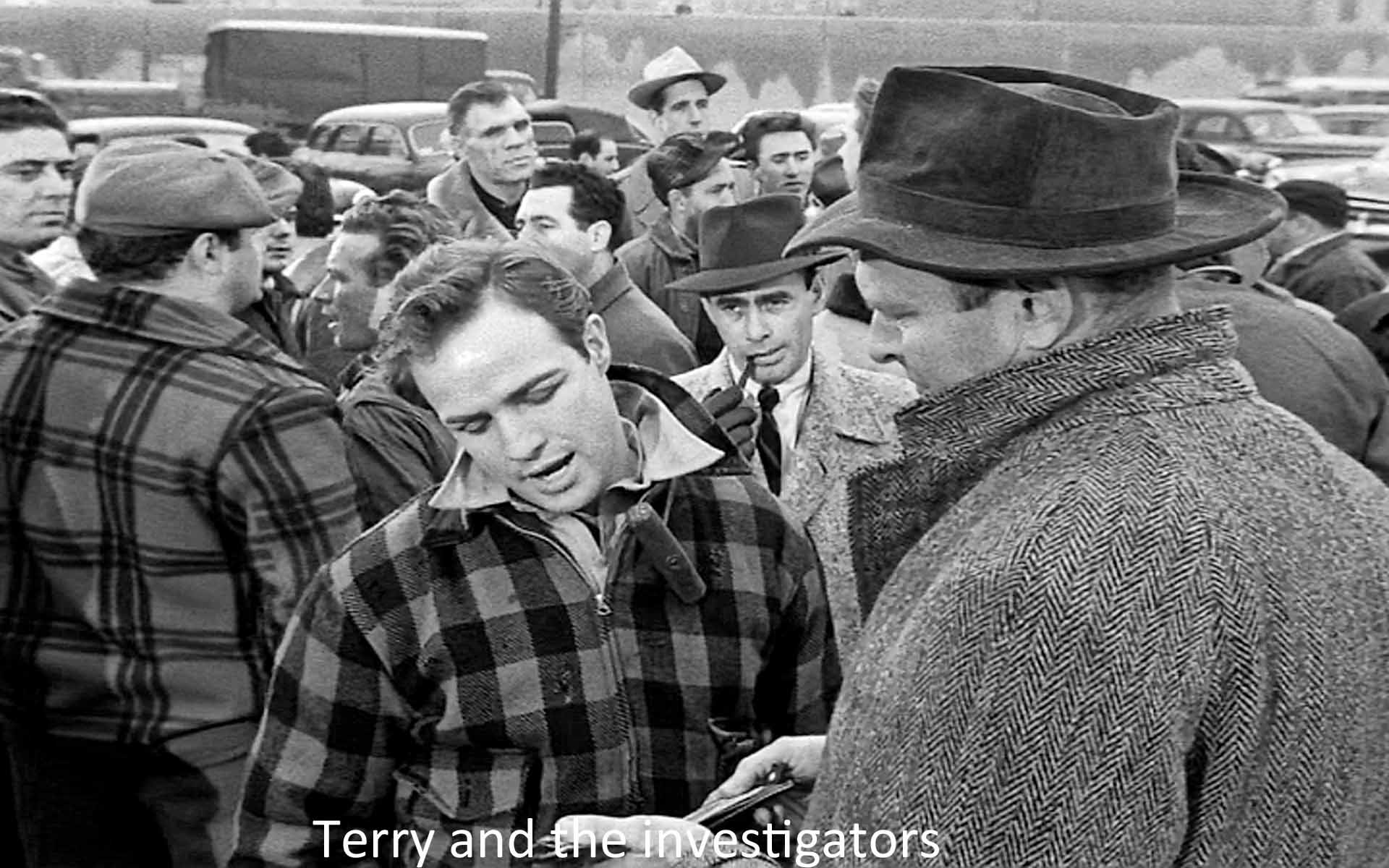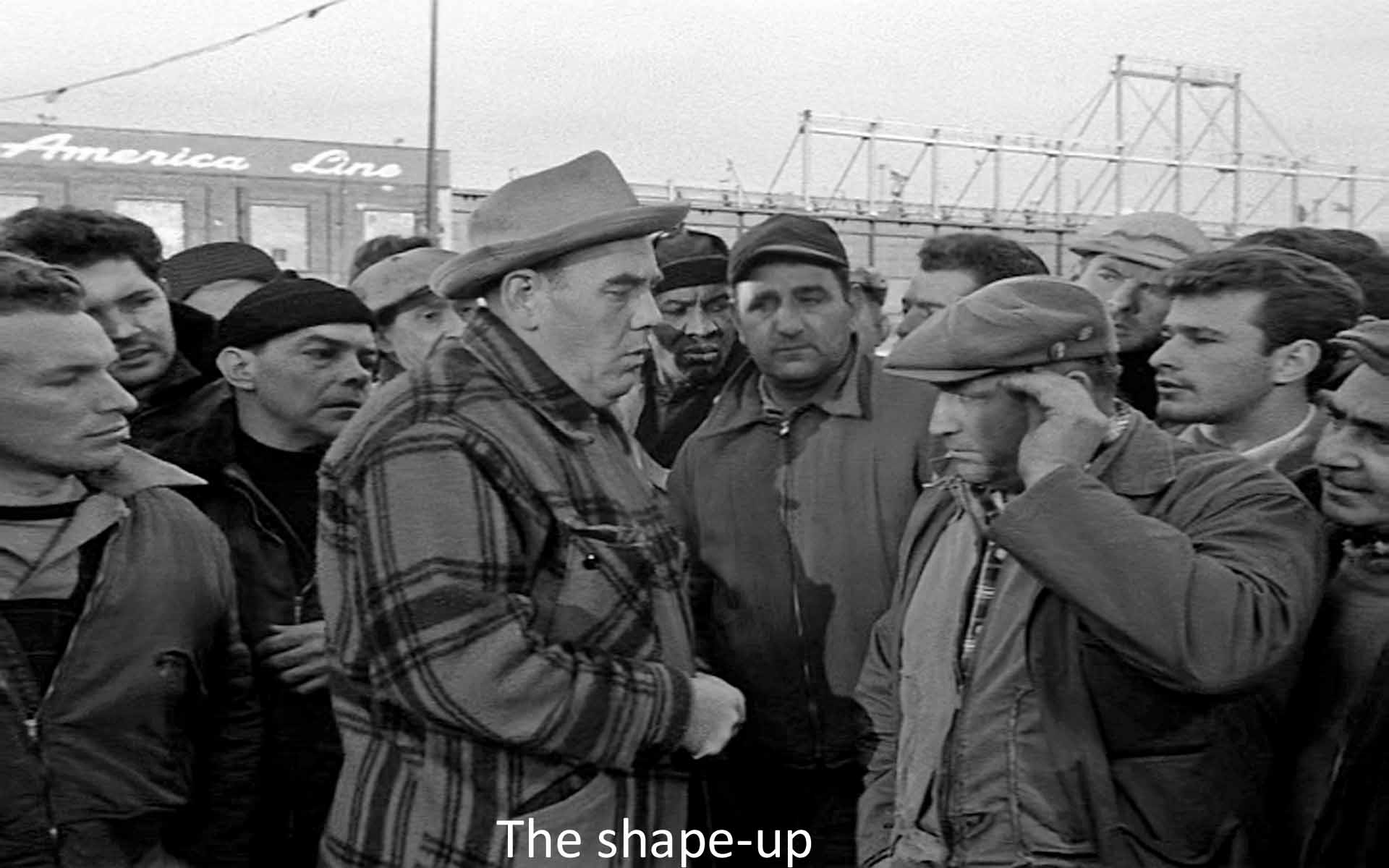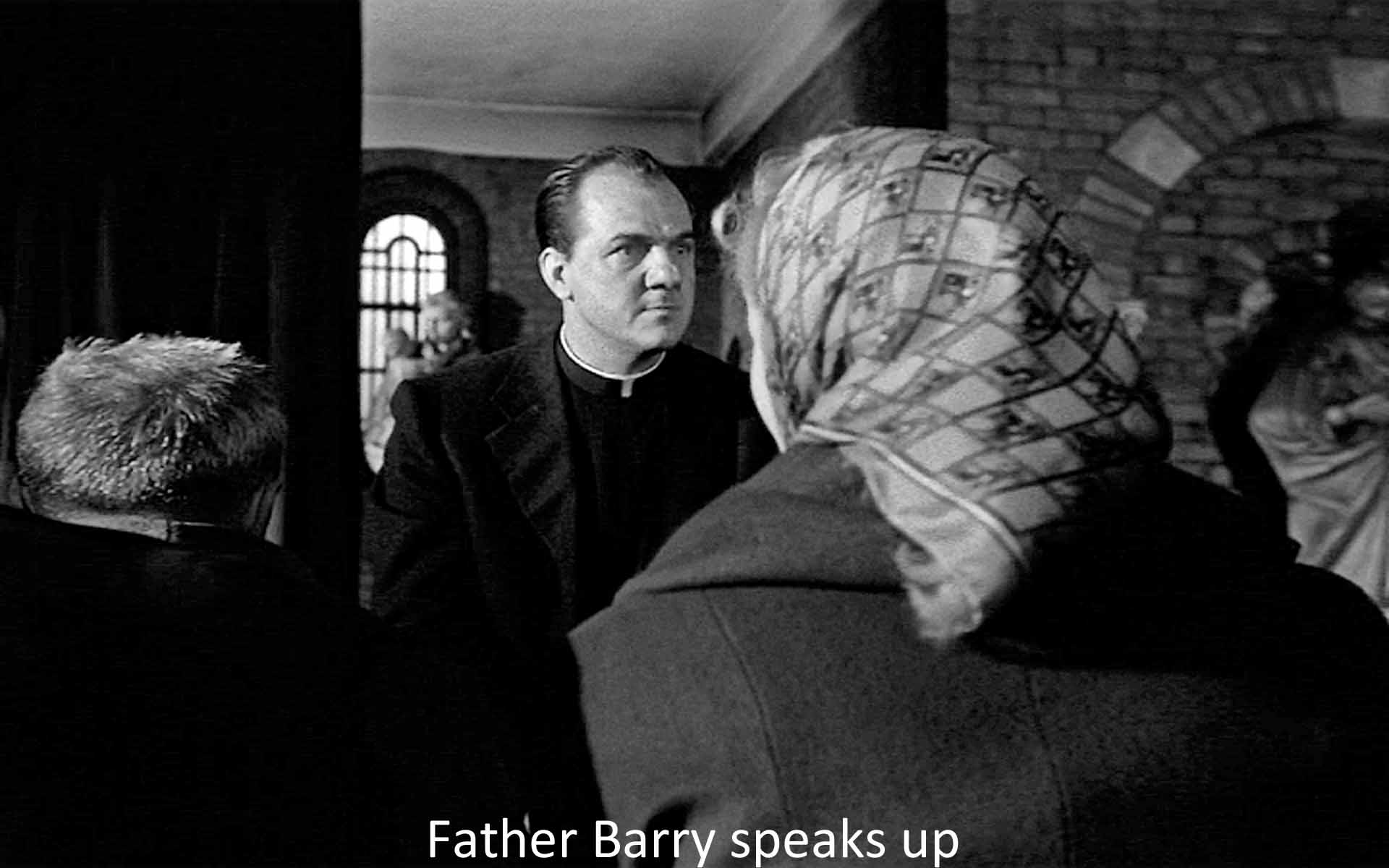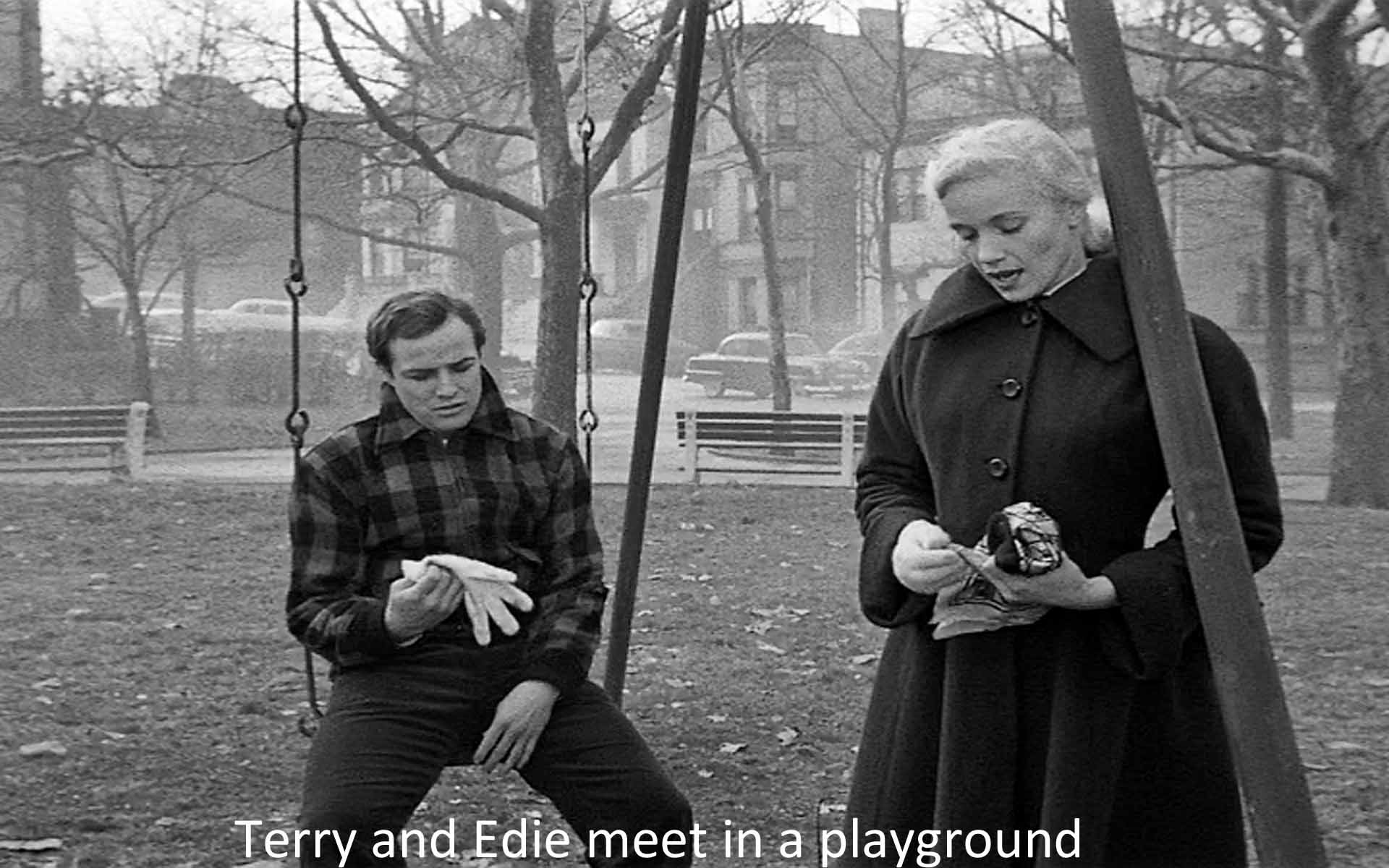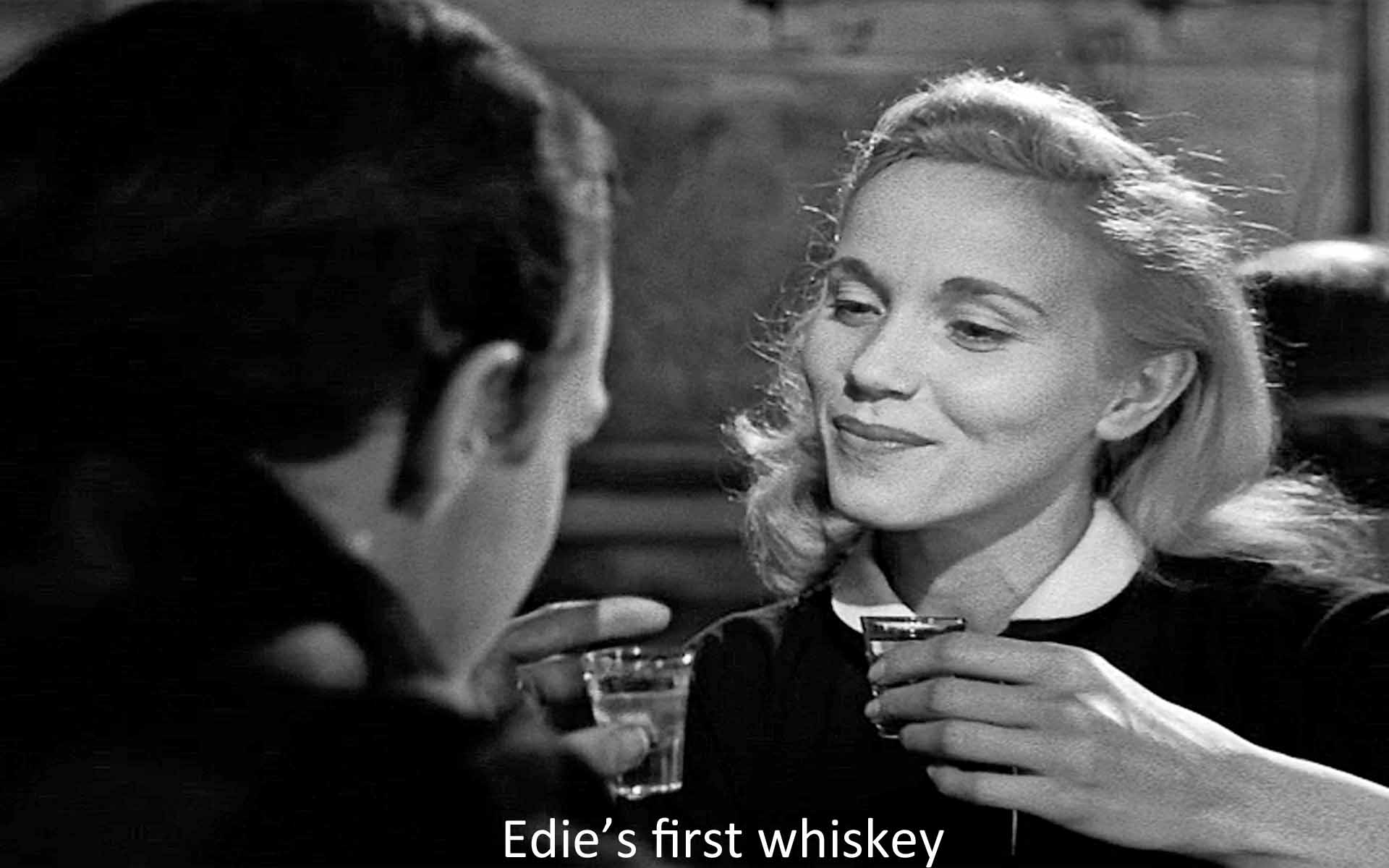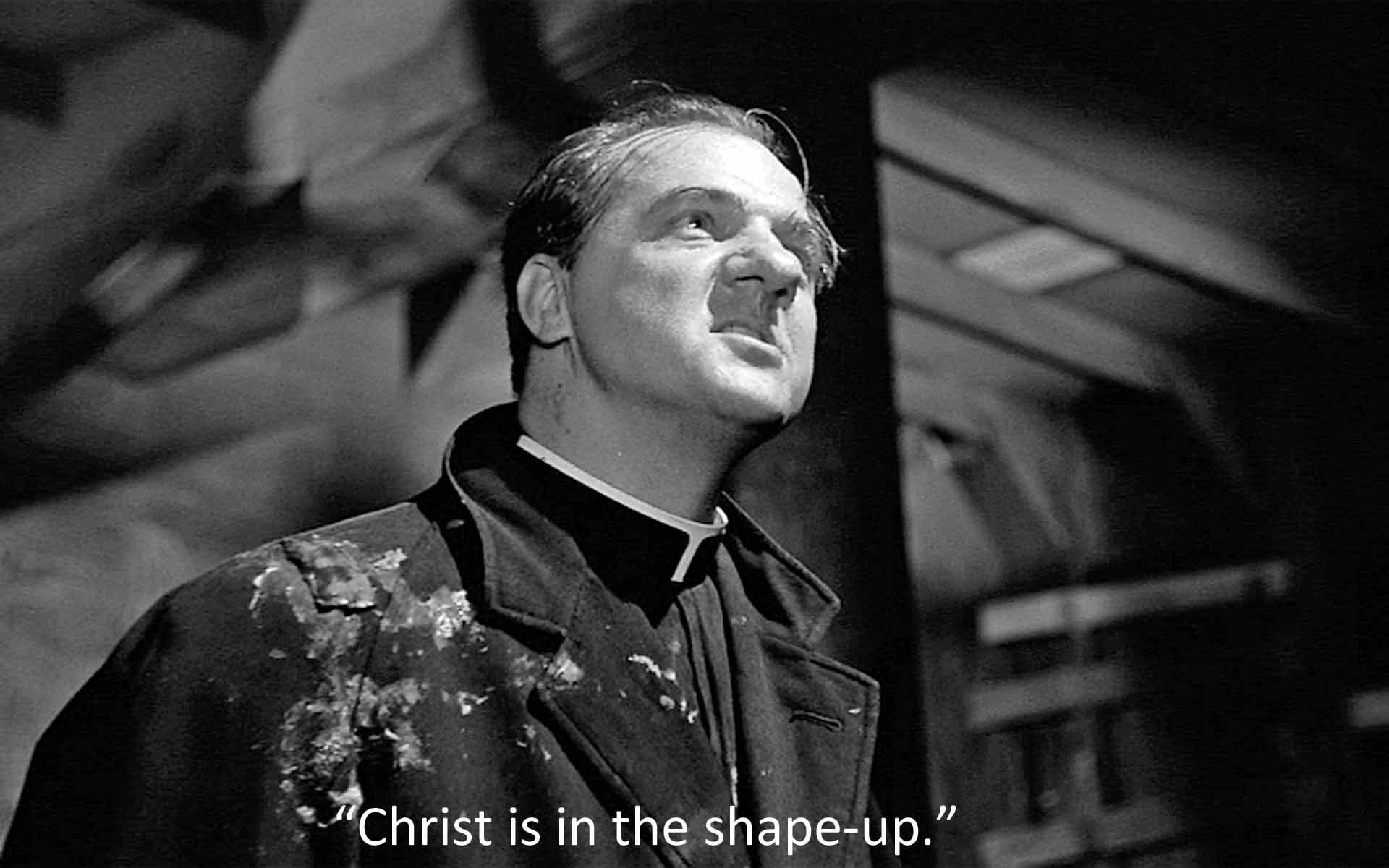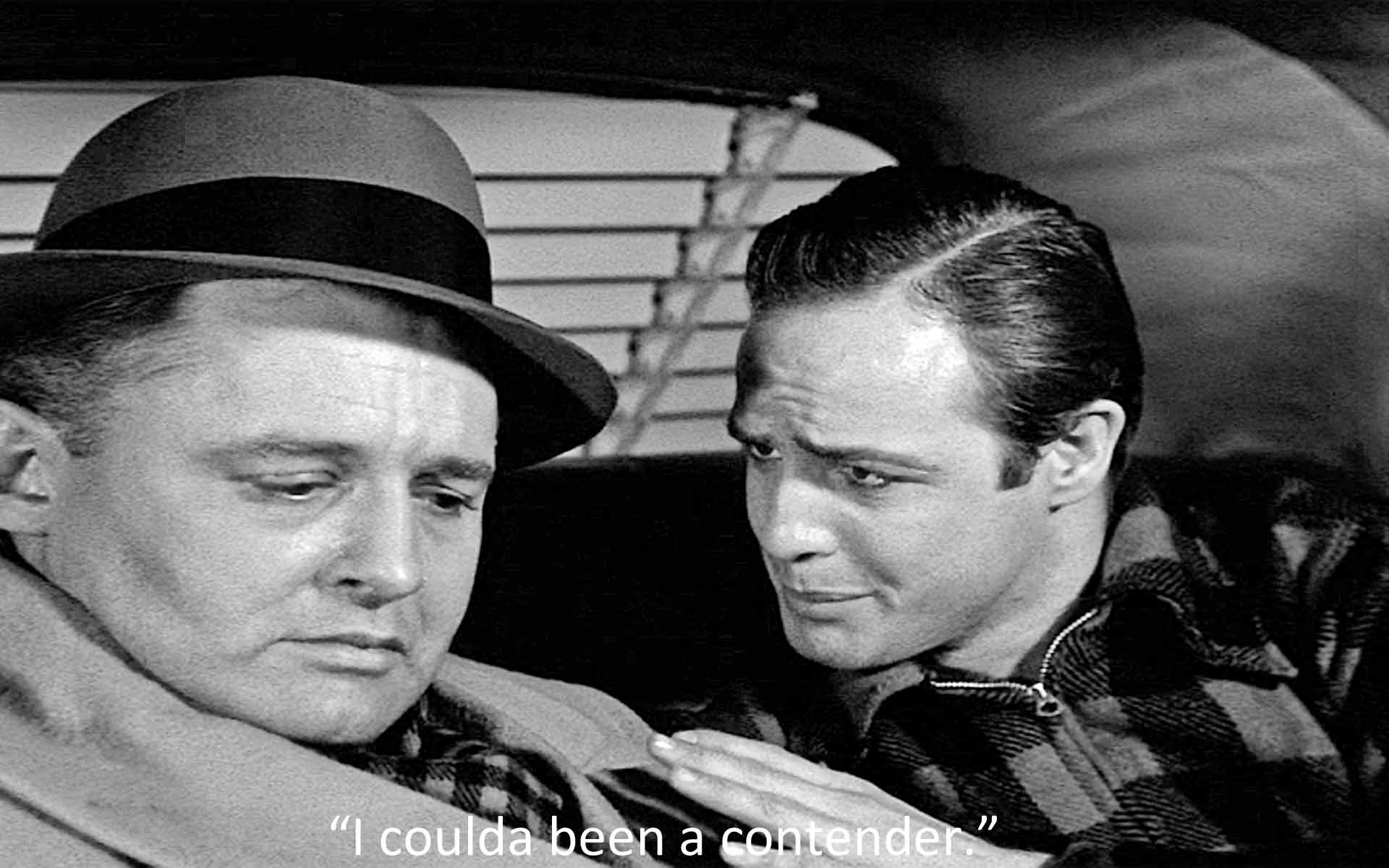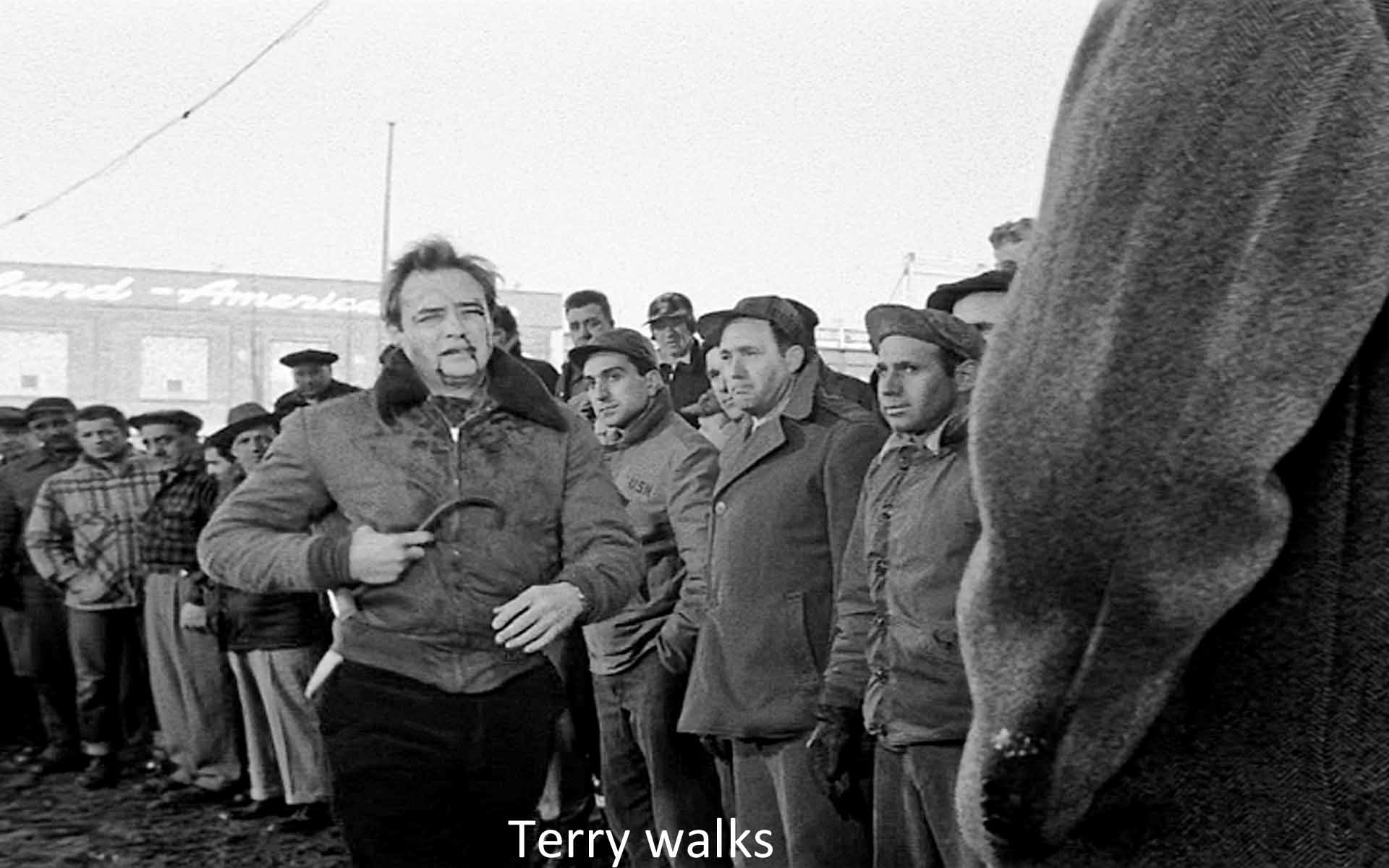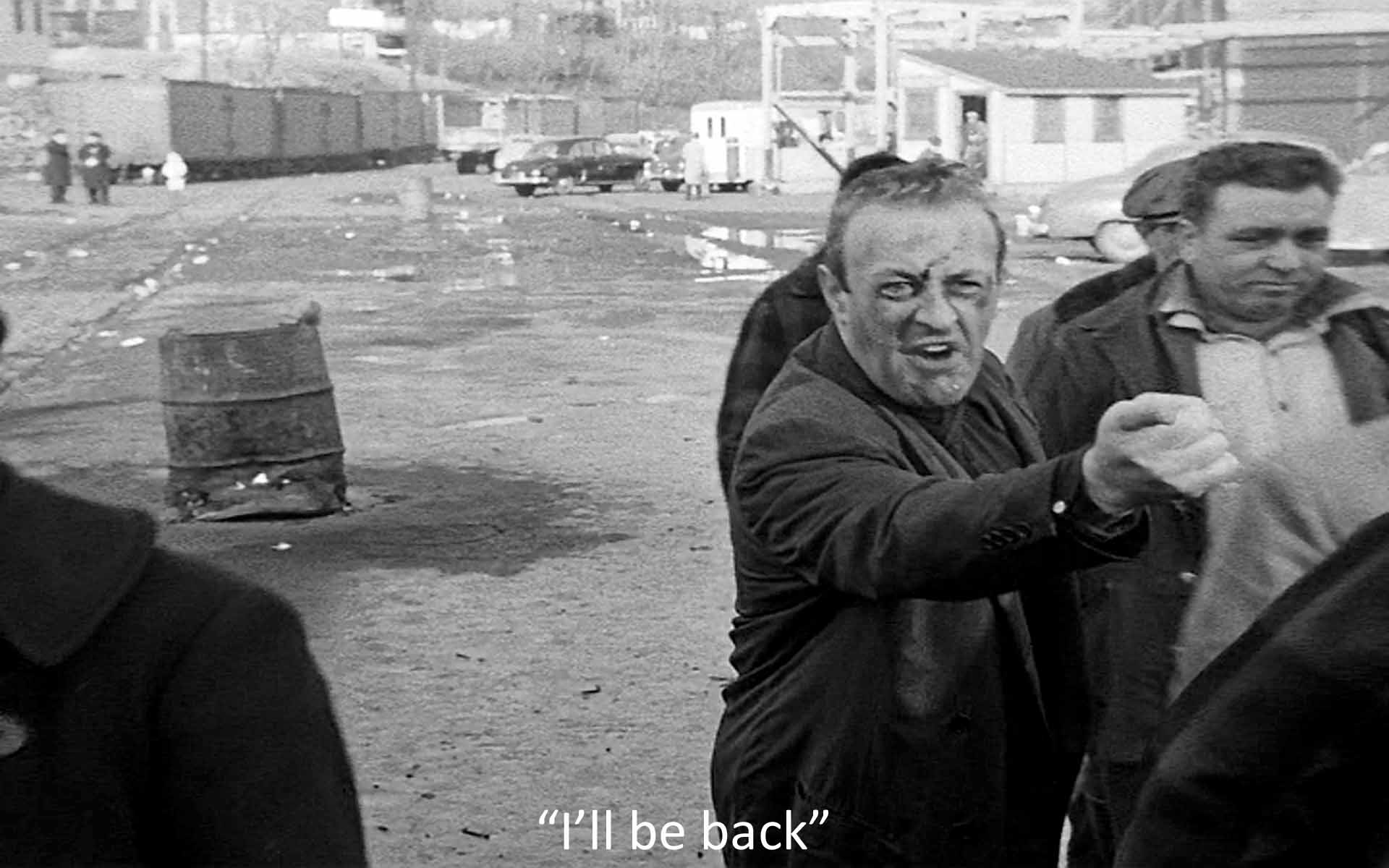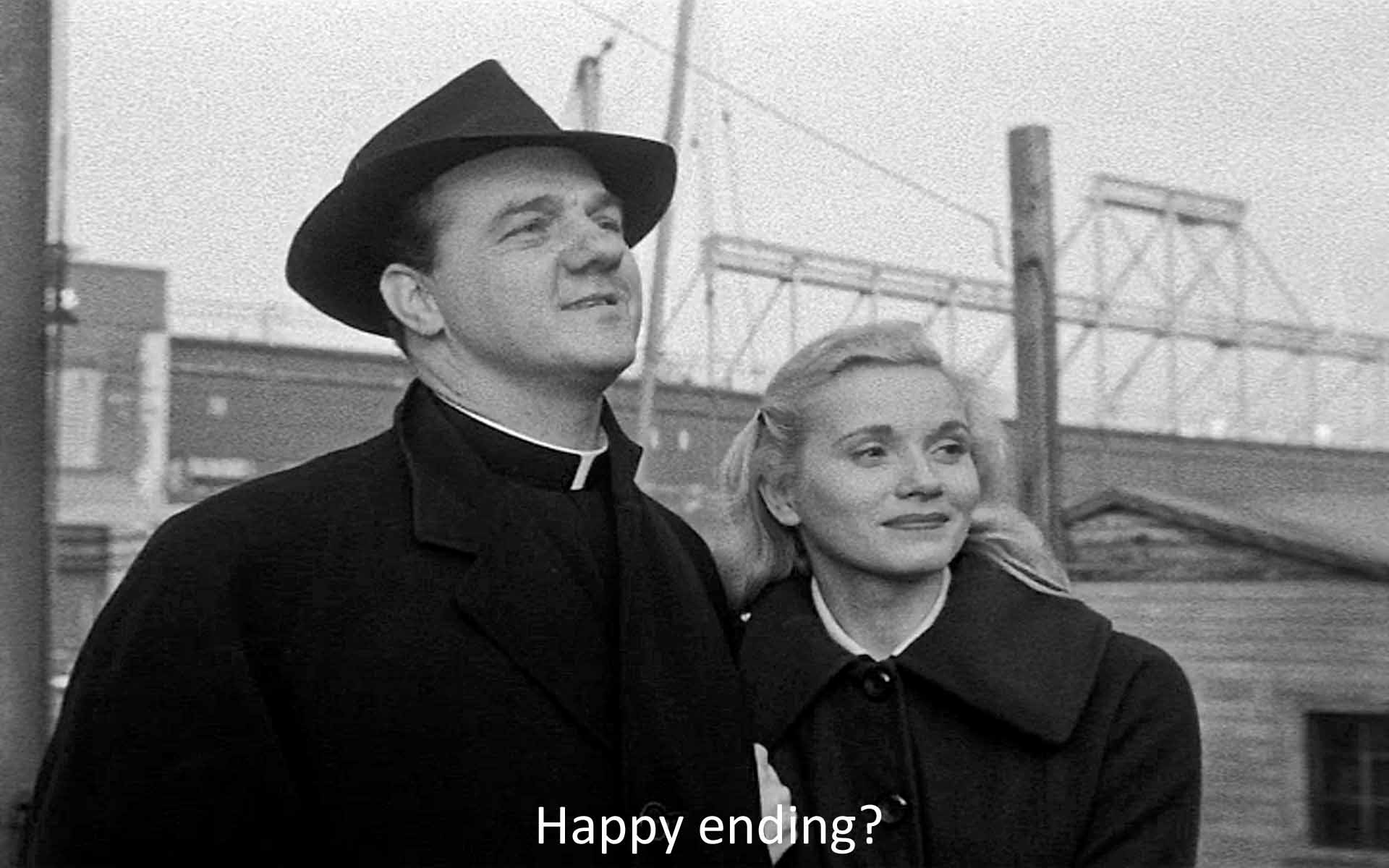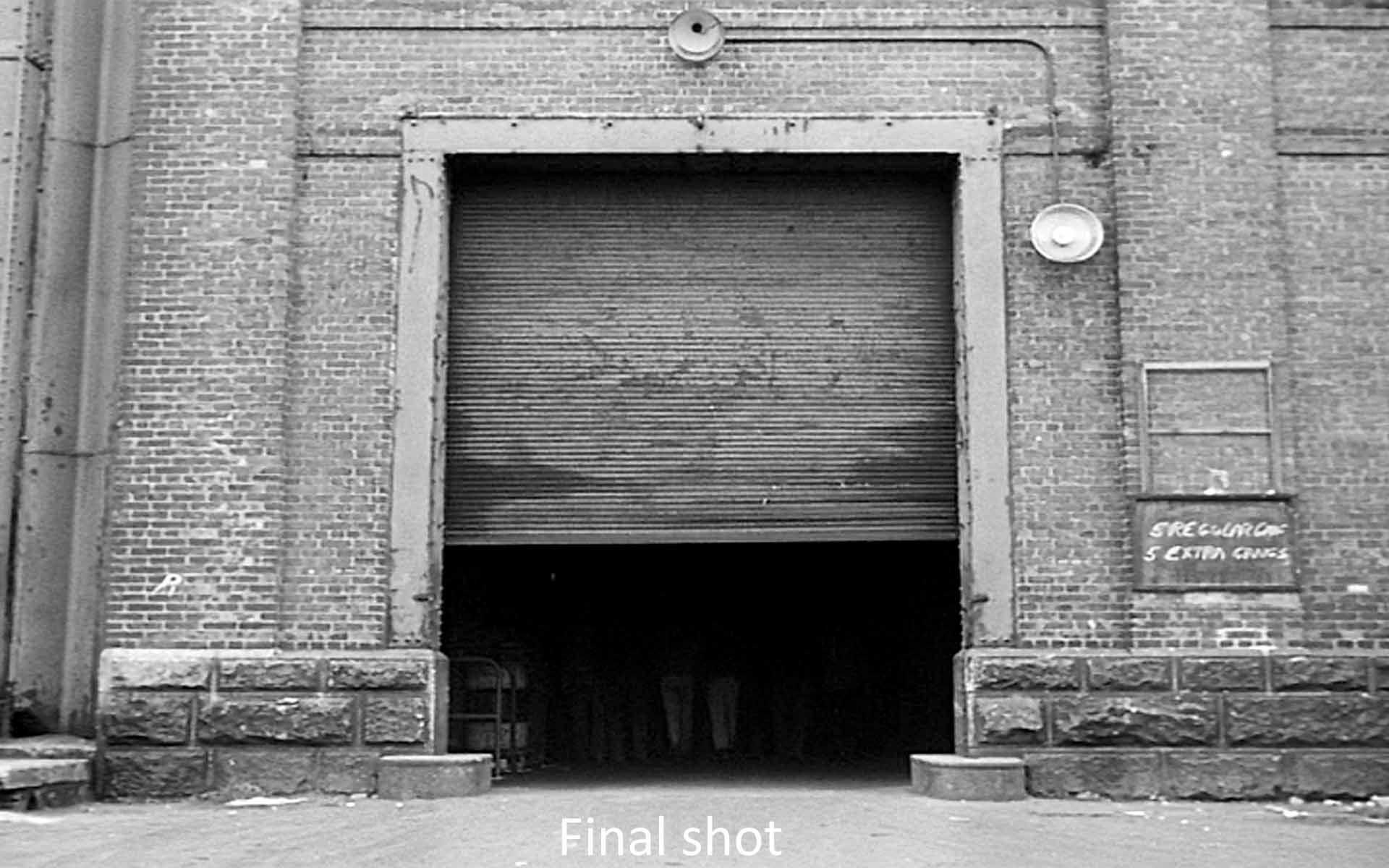Elia Kazan wrote on the first page of his shooting script for On the Waterfront: “Don’t be objective! This is not a Documentary.” Right! This is not a documentary about corruption on the docks. “On the Waterfront,” writes Michael Almereyda, “is no more about the real business of the docks—working conditions, union racketeering, or reform—than Hamlet is an exposé of corruption in the medieval Danish court.”
Nor is it about Kazan’s naming names to the House Un-American Activities Committee. True, it is the story of Terry Malloy’s “ratting” on the criminals who have taken over the longshoremen’s union. He is a stool pigeon and a betrayer who violated the dockworkers’ code of silence (“D and D,” deaf and dumb). Inevitably, there has been a slew of fervid articles claiming or denying that Terry Malloy is a stand-in for Kazan. Yes, Kazan did go before the House Un-American Activities Committee and name those with whom he had been a communist in his early days on the Group Theatre, ruining lives and careers. (And his screenwriter Budd Schulberg also named names.) But Kazan antagonized liberals further by taking out a defiant ad in the New York Times justifying his action. Fifty-five years later, when he got his lifetime achievement award from the Motion Picture Academy, there were still people mad at him (and the Academy). But On the Waterfront is not about all that.
Kazan also wrote on the first page of his shooting script: “PHOTOGRAPH / The inner experience / OF TERRY.” On the Waterfront, as many critics will tell you, tells the story of Terry Malloy’s soul and his redemption. Marlon Brando plays Terry Malloy in what many think is Brando's greatest role. He is an ex-boxer, once promising, now punch drunk, a "bum," and a “palooka.” Terry is a hanger-on, occasional errand boy, and butt of jokes for the corrupt union boss Johnny Friendly (Lee J. Cobb). He gets favors through his brother, Charley, the “Gent” (Rod Steiger). Charley is brainy, went to college, and keeps Friendly’s non-existent books in his head.
The film opens with Johnny Friendly and his henchmen leaving their waterfront headquarters, having given Terry his orders. Terry lures his friend Joey Doyle up to the roof from which they both fly pigeons. There, Joey is, to Terry’s surprise and regret, killed by other union goons. “I figured the worst they was gonna do was lean on him a little bit.”
Driven by the murder, Father Barry (Karl Malden) urges the longshoremen to rise up against the corrupt union bosses. He tries to get one or more of them to testify to the Crime Commission that is investigating corruption in the longshoremen's union. The dead man’s sister, Edie Doyle (Eva Marie Saint in her first movie role), gets friendly with Terry and also tells him he should stand up to the crooks and testify. “Shouldn't everybody care about everybody else?” Gradually, Terry begins to come round to Edie’s point of view, but the crucial step comes in a famous scene between Terry and his brother in the back of a taxicab and its aftermath.
Charley Malloy is brainy and “Johnny Friendly's right hand and a butcher in a camel hair coat.” In the cab, he tries to persuade his brother not to testify, first by tempting him with a soft, high-paying job, then by threatening him with a gun. But Terry reminds Charley of the night his brother made him take a dive in the ring so that Charley and his bosses could make big money on bets, and that was the end of Terry’s boxing career. In a famous speech, “I coulda been a contender. I coulda been somebody. Instead of a bum, which is what I am. Let’s face it. It was you, Charley.”
Charley has failed to shut his brother up, and Johnny Friendly has him killed. This finally pushes Terry over the edge. After futilely trying to shoot Friendly, he goes before the Crime Commission and tells how Joey Doyle was murdered and by whom.
That is the major plot, but there is a sub-plot as well. We see two childlike people brought to adulthood. Terry, punch-drunk, is naive and childish. Edie has been schooled by “the sisters” up in Tarrytown where she is studying to be a teacher (as she will be to Terry). “I guess they don't let you walk with fellas where you've been.” Edie has never drunk a beer and may never have kissed a “fella.” She and Terry meet and begin their friendship in a playground. They continue on the roof with Terry’s pigeons and his pre-teen fans in their Young Warrior jackets. Finally they go to a bar where Edie has her first beer and a shot and tries to persuade him to her own Christian values. He laughs her off, but, at Father Barry’s urging, he tells her his part in her brother’s death. She furiously rejects him. He comes to her apartment, she tells him to stay away, but he breaks in. She is dressed only in her slip, but he insists that she loves him. He grabs her. They embrace. She melts, and the movie goes back to the Johnny Friendly plot and a kind of happy ending with Father Barry and Edie beaming at Terry’s sort-of victory. Two childlike people have come to an at least potentially sexual adulthood, paralleling the longshoremen’s achieving their independence.
Change was an important theme for the immigrant Kazan. He went through many changes in his own life: different theater groups, disillusionment with his early political views, signing into the Hollywood system, going from one actor to another, different wives, many affairs, and so on. On the Waterfront is a movie about change: the change in Terry, in Edie, and in the longshoremen. And for change, the pigeons are again a symbol.
Terry and Joey were enjoying the sport of pigeon flying or pigeon racing. One would release a specially bred and trained pigeon somewhere miles from its home, and it flies back. The competitors record the time, and the fastest pigeon wins for its owner. The sport was particularly popular in New York because you could play it from an apartment roof. And it was a poor man’s sport. You may not be able to afford a racehorse, but you can afford a pigeon.
Pigeons stand for the longshoremen who are subject to hawks—the crooks who prey on them. But also pigeons repeat. They are trained to fly to a certain home, and they can’t change. They echo here the longshoremen’s unwillingness to change their working conditions even though those conditions are awful. And once all Terry’s pigeons are dead, he can confront Johnny Friendly and change the way the longshoremen get their jobs.
People always speak of Kazan as an actor's director, and he surely was. In this film, he imitated the Italian neo-realists by using non-professionals. Most of the longshoremen were real dockworkers, and some of Friendly’s goons were real ex-heavyweight boxers.
But Kazan was equally capable of using purely filmic techniques, particularly when working with so talented a cinematographer as Boris Kaufman. Kaufman used contrasty black and white for the noir scenes, threats, attempted killing, or murder. But he deliberately grayed out the daytime scenes on the waterfront and in the city. He and Kazan were imitating the look the neo-realists achieved. But they were also suggesting, many critics have claimed, the moral ambiguity, the gray, of the situation. To be sure, Kaufman was aided by the actual fog and the cold winter air. Kazan was filming during one of the coldest winters New York had seen. His chief problem, he later said, was getting actors and extras to show up for work in that bitterly cold wind off the Hudson River.
No wonder coats and jackets became a recurring symbol in the film. People are identified by what they wear against the cold. Friendly and Charley dress expensively. Charley, Terry’s brother, is “a butcher in a camel hair coat.” (I suppose it is conceivably relevant that a camel is a beast of burden like a longshoreman.) The investigators for the crime commission (Leif Erickson, Martin Balsam) stand out in their tweed overcoats that set them apart from the longshoremen in their old bomber jackets. Thugs splatter muck on the priest’s long black overcoat when he delivers his Christ-is-in-the-hold homily. Terry’s young fan wears a “Golden Warrior” jacket, and Terry himself says, “[You] might say that I was the original Golden Warrior.” In the course of the movie, the jacket in which Joey Doyle died passes from murdered Joey to murdered Kayo Dugan to Edie and finally to Terry himself. Jackets mark intimacy and fellowship as well as class divisions.
When the characters get out of the cold, they exist in narrow, confining spaces: the union headquarters, the holds of ships, Johnny Friendly's bar and the crowded back room where he conducts his business. Other cramped spaces: the bar where Terry and Edie begin their relationship; Edie and her father’s crabbed apartment; the alleyway where the workers are ambushed after the meeting in the church: the back seat of a taxi (shut in with Venetian blinds); the crowded room where the Commission's hearings are held. All echo the congested situation of the longshoremen in this lethal but intimate system.
Among these confined spaces are the chickenwire cages on the apartment house roof from which Terry (and Joey Doyle) flew their pigeons. Screenwriter Budd Schulberg supplied Kazan with this thematic element. The space is open, but the pigeons are confined. In that they stand for the longshoremen. "They get married just like people."
Terry tells Edie about the hawks who prey on the pigeons: "You know this city is full of hawks? That's a fact. They hang around on top of the big hotels." "They spot a pigeon in the park—right down on them." Later we get a glimpse of "Mr. Upstairs," Friendly's boss. If the longshoremen are pigeons, Friendly and his gang and Mr. Upstairs are the hawks.
Terry's loyalty to Friendly’s gang expresses the political theme of the movie: the contrast between the Christian and humanist value of brotherhood as opposed to the racketeer’s (and the businessman’s?) treatment of money as the ultimate value. The hawk-and-pigeons analogy stands for a social Darwinism that would treat ruthless laissez-faire capitalism as "natural." Just as Terry accepts the existence of hawks, he accepts the existence of the Johnny Friendlys. Edie is different: schooled by "the sisters," she says, "Shouldn't everybody care about everybody else?" "I mean, isn't everybody a part of everybody else?” Terry dismisses this as “that drool.” His code he tells her is, “Do it to him before he does it to you.”
Terry uses a pigeon to lure the "canary," Joey Doyle to his death. "Pigeon" suggests "stool pigeon," as Terry (and Kazan) were. After Dugan "sings" to the Crime Commission, Friendly says, "Why, that crummy pigeon. He ought to have his neck wrung!" That is what Terry's young "Golden Warrior" fan does after Terry testifies; he kills all of Terry's pigeons: "A pigeon for a pigeon."
Brotherhood goes two ways, Edie’s and the priest’s way and the way of the longshoremen’s culture. Terry finds, after he has testified, that the longshoremen and even his young Golden Warrior turn against him. This loyalty to the group—even a group that cheats and murders you—points to the largest issue the film explores. We primates are social animals. Loyalty to our troupe or tribe has to be a fundamental biological principle of our existence. But we primates have bigger brains than our hairier relatives. We can and do arrive at individual ideas and values other than just sticking with the tribe. Reconciling our individual values with loyalty to our group then becomes a profound problem for us, an issue deeply embedded in our brains.
On the Waterfront offers no final answer. Historically, it took several years and elections for the docks to be cleaned up. As for the film, its ending is ambiguous. The last words of the film are Johnny Friendly's furious cry, "I'll be back! Don't you forget that! I'll be back!” I have no doubt he or someone like him will. We get a glimpse of the ultimate capitalist who is Friendly's boss, “Mr. Upstairs." The Crime Commission hasn't touched him. I don’t share the faith, often professed by our politicians, that democracy is the natural and inevitable order for human beings. As I look at Africa or the Middle East or Eastern Europe or East Asia, I see democratic revolutions that turn into tyrannies that thrive and reproduce. And I read the ending of On the Waterfront as equally pessimistic. Father Barry and Edie smile unconvincingly, but the door to the dock rolls down, locking the men inside as they go to work for a new boss and old conditions. The hawks don't go away, and the pigeons are always pigeons.
Father Barry and Edie beam smugly as Terry leads the longshoremen, if to say, we’re so proud of our Terry. This pseudo-happy ending has triggered a critical dispute. Led by filmmaker Lindsay Anderson in Sight & Sound a number of critics consider the final presentation of Terry as a Christ-like hero to be a shameful betrayal of the longshoremen. Terry is another “leader” who has come to power with his fists as Johnny Friendly did. The real problem, the exploitation of the men, something that needs social and political reform, gets buried in one man’s heroism and triumph. (American movies from the 1930s on characteristically perform this turn.) A new boss calls the men back into the hold to endure the same hard working conditions they faced at the beginning of the movie. And Kazan’s HUAC testimony feeds this reading of the film as a sell-out.
However one reads the ending, though, the film is a masterpiece of acting, photography, writing, and even the music, Leonard Bernstein’s one and only film score (that Kazan didn’t like—“too intrusive”). Like all great films, it asks us in the audience to take it seriously and try to understand how we can perceive all these different elements as exploring our human situation. Here, it is loyalty to the tribe in conflict with higher values held by an individual in that tribe.
